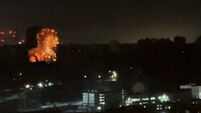‘One-in-a-billion chance' of similar Concorde crash
Concorde went back into passenger service today fitted with the kind of bullet-proof protection more normally associated with police and military jackets.
But the Kevlar-rubber lining of the fuel tanks on the supersonic planes is essential to avoid any repeat of the tragic events which downed the Air France Concorde in July 2000.
And the fitting of the lining is just one of a number of modifications that both British Airways and Air France have made to their Concorde fleets.
More than 100 individually-shaped sections of Kevlar composite material have been precisely engineered then fitted by hand into the extremely constricted fuel tanks within Concorde’s delta wings.
These cardboard-thin liner pieces range from 1.2 metres to 1.8 metres in length and are 30-45cm wide.
They are there to prevent a recurrance of the devastating puncturing of a tank from the shattered tyre that caused last year’s terrible crash.
Fitting the linings will mean that any fuel leakage from a 30 sq cm hole will be reduced from 100 litres a second to just one litre per second.
Kevlar’s makers reckon that the linings will contain and reduce leakage ‘‘to a level where ignition would be virtually impossible’’.
Not only used for bullet-proof vests, Kevlar is also used to strengthen bridges against vehicle impact and for vehicle armouring.
Also, both BA and Air France have fitted tough new Michelin tyres to their Concordes. These tyres prevent the risk of tyre bursts and, in case of tyre failure, the debris being released is of a much lower mass, insufficient to lead to fuel tank perforation.
In addition, both airlines have strengthened the wiring in the undercarriage area of the supersonic aircraft to eliminate the risk of ignition.
Having returned permission-to-fly certificates to the planes in early September, the Civil Aviation Authority said there was ‘‘less than one in a billion chance’’ of a similar crash.














